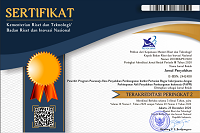Perilaku Menonton dan Kepuasan Petani terhadap Program Merajut Asa di Televisi TV Trans7
Abstract
This study aims to identify the behavior of the audience watching television, as well as analyzed the relationship between viewing behavior with the level of audiences satisfaction the programs Merajut Asa TV Trans7. The method was used in this study is a survey method with the quantitative approaches supported by qualitative data. The results of this study explain the choice of the most popular by farmers is the program information and entertainment. Farmers have a low duration of watching television, i.e. during 7,50-45,75 minutes/day, as well as the duration of watching programs Merajut Asa TV Trans7 also low, i.e. during 1-15 minutes. Farmers have a low frequency of watching television, the only watch 1-4 times a week. Frequency of watching programs Merajut Asa TV Trans7 also low, i.e. 1-2 times a month. Duration of watching is not associated with the level of audiences satisfaction. Frequency of watching associated with the level of audiences satisfaction, i.e. satisfaction information.
Keywords: viewing behavior, viewing satisfaction, merajut asa program, TV
Downloads
Authors who publish with this journal agree to the following terms:
- Authors retain copyright and grant the journal right of first publication with the work simultaneously licensed under a

This work is licensed under a Creative Commons Attribution 4.0 International License that allows others to share the work with an acknowledgement of the work's authorship and initial publication in this journal. - Authors are able to enter into separate, additional contractual arrangements for the non-exclusive distribution of the journal's published version of the work (e.g., post it to an institutional repository or publish it in a book), with an acknowledgement of its initial publication in this journal.
- Authors are permitted and encouraged to post their work online (e.g., in institutional repositories or on their website) prior to and during the submission process, as it can lead to productive exchanges, as well as earlier and greater citation of published work (See The Effect of Open Access).















